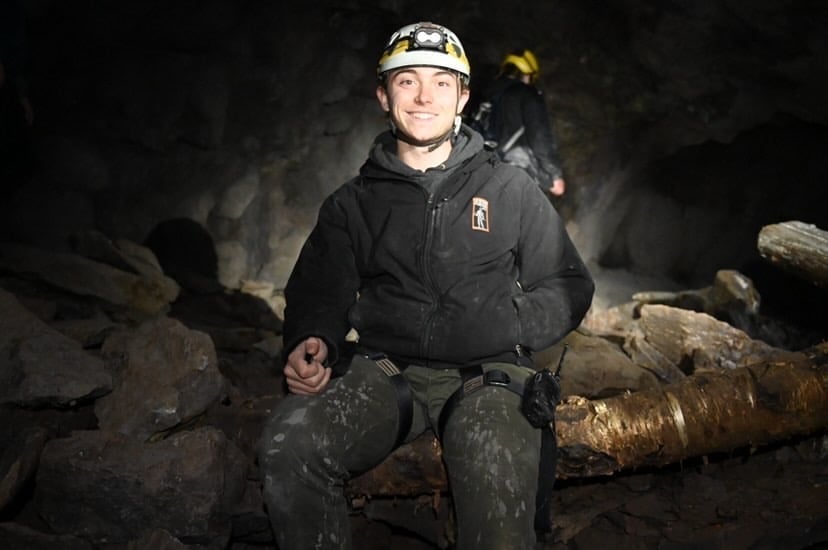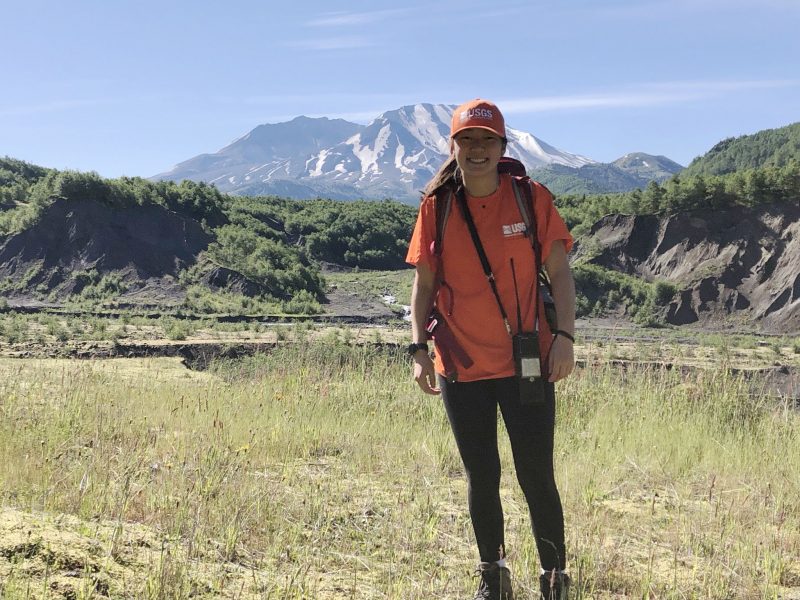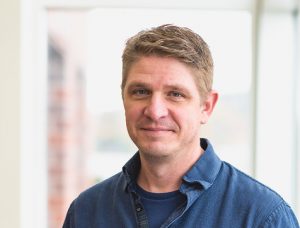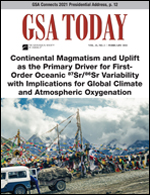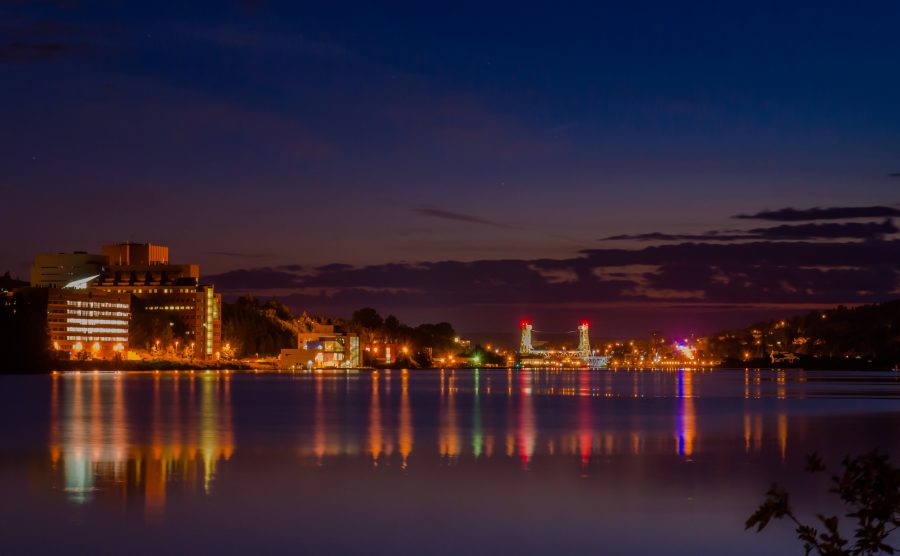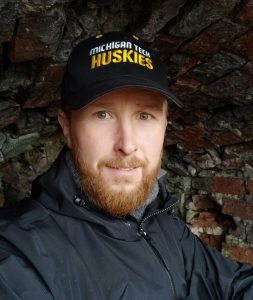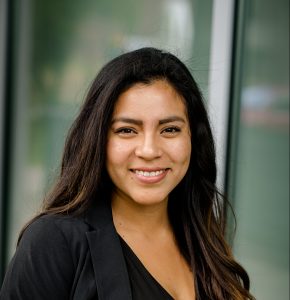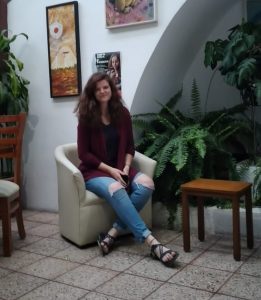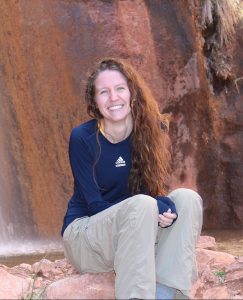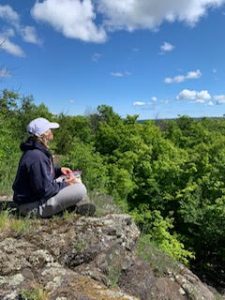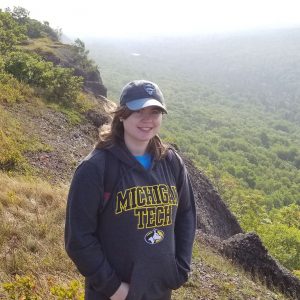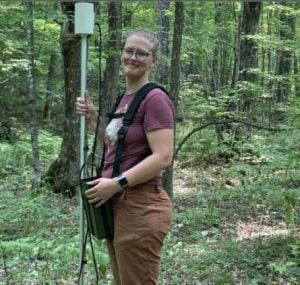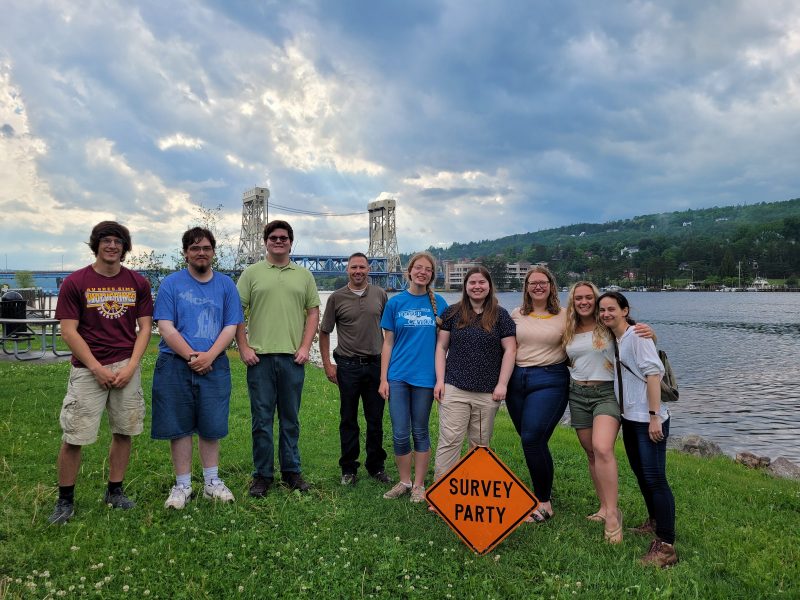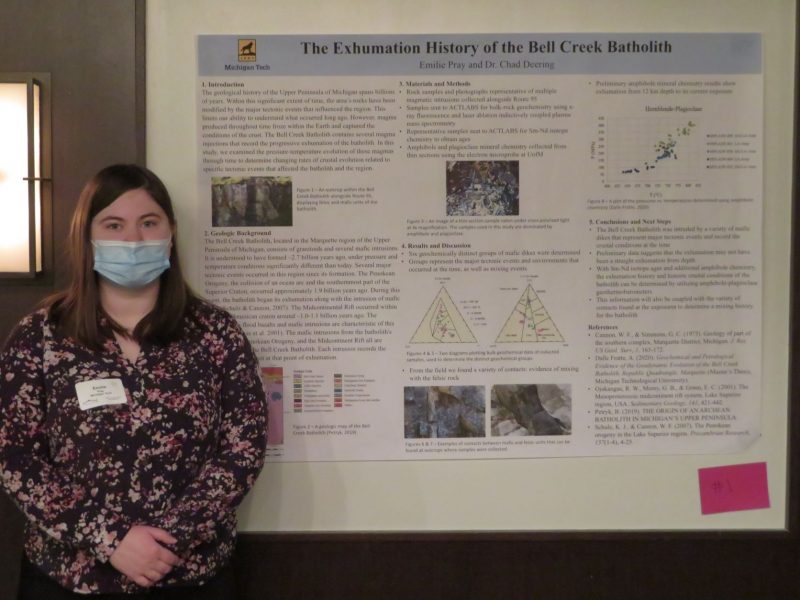Congratulations to Jake Maxon (BS Mining Engineering), who received a 2022 GMES Department Scholar Award to recognize his scholarly achievements! This award, presented to a student entering their senior year, recognizes one who best represents student scholarship in the department by participating in research or scholarly activities, demonstrating a high level of intellectual curiosity and creativity, and showing excellent communication skills. Jacob participates in research led by Associate Professor Dr. Snehamoy Chatterjee on fire size and fire location optimization in an underground mine using machine learning. Jacob is also involved in multiple mining-related activities within the campus and the community, including community-based research to map historical documents, including mining documents.
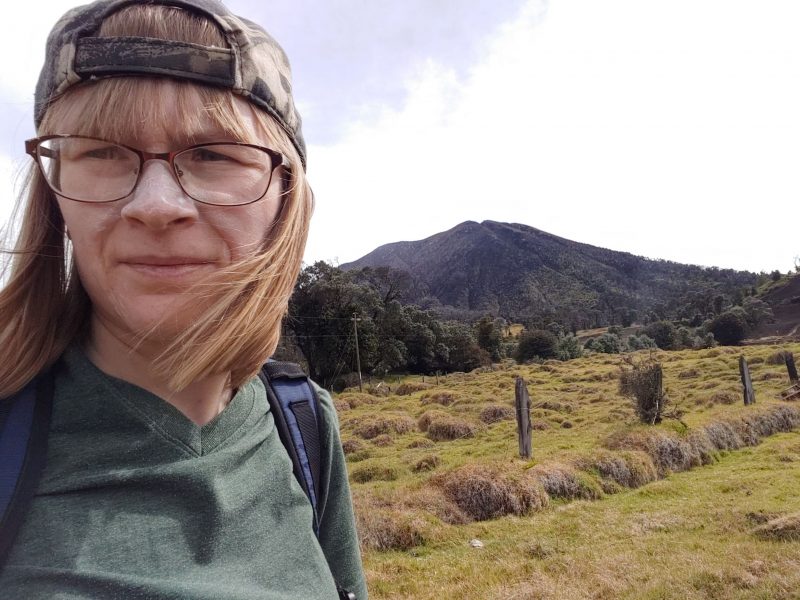
Emmeline Wolowiec, MS geology student, is recognized for her academic accomplishments, receiving the Dean’s Award for Outstanding Scholarship in the Geological and Mining Engineering and Sciences Department. A certificate of recognition for this award will be presented to Emmeline at the Graduate Research Colloquium Banquet held this spring.
Emmeline, advised by Dr. Chad Deering, is working to look at the generation of high silica magmas in Costa Rica. They’re looking at the connection between plutonic and volcanic rocks to see what that can tell about where in the crust the volcanic rocks formed in relation to the plutonic rocks and what the possible magma chamber structure looked like. Hopefully, this will give insight into how the volcanic rocks formed, whether through fractional crystallization, magma mixing, or other processes.
After joining the GMES graduate program in the fall of 2021 to pursue a master’s degree in geology, Natalea Cohen applied for and was recently awarded the 2022 Graduate Visitor Program at the National Center for Atmospheric Research (NCAR). NCAR is sponsored by National Science Foundation.
“I am honored to have received this opportunity to work with David Yates at NCAR and apply the skills and knowledge gained from my time at Michigan Tech. I will be at NCAR in spring 2023 modeling hydrometeorological data that will be collected in El Salvador this coming summer 2022.” – Natalea Cohen
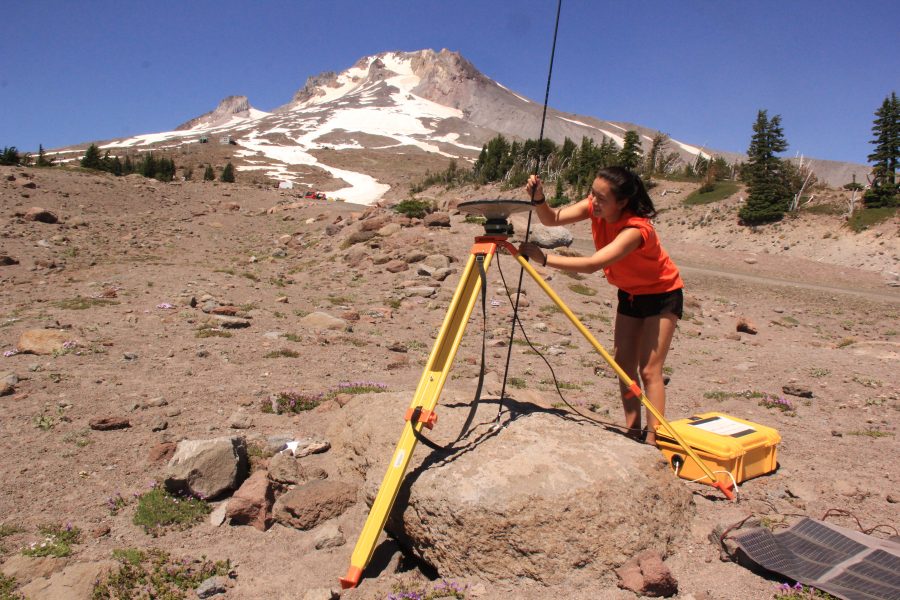
The area around Three Sisters volcanoes in Oregon is moving, and geology MS student, and NAGT/USGS intern Natalea Cohen, demonstrates the portable GPS monitoring equipment used to track it. Uplift, a subtle rise in the ground’s surface, is monitored by the USGS Cascades Volcano Observatory. Could magma underground be to blame? See how radar satellite data and GPS equipment come together to get scientists one step closer to knowing the truth: https://www.youtube.com/watch?v=0QfARy8zPEk
Chad Deering (GMES) was quoted in a University of Wisconsin Oshkosh news story picked up by Science Daily and Phys.org. The story explains how a study led by Deering and UW-Oshkosh geologist Timothy Paulsen links zircon data from sandstones recovered from Earth’s major continental landmasses to the evolution of the Earth’s rock cycle and its oceans. Snehamoy Chatterjee (GMES) is also a co-author on the study.
“Continents tend to be worn down by weathering and rivers tend to transport this sediment to the oceans, leaving scattered puzzle pieces for geologists to fit together,” said Chad Deering, a Michigan Tech geologist and coauthor on the paper. “There is increasing evidence that important pieces of the puzzle are found in the ancient beach and river sediments produced through continental weathering and erosion.”
Read more at UW Oshkosh Today, by Natalie Johnson.
Continental Magmatism and Uplift as the Primary Driver for First-Order Oceanic 87Sr/86Sr Variability with Implications for Global Climate and Atmospheric Oxygenation
T. Paulsen, C. Deering, J. Sliwinski, S. Chatterjee, and O. Bachman
GSA Today, pp. 4–10, 2022.
doi.org/10.1130/GSATG526A.1
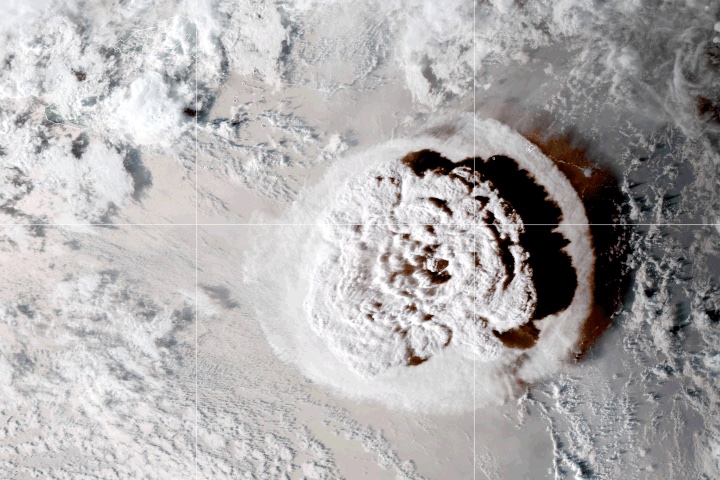
A powerful volcanic eruption has obliterated a small, uninhabited South Pacific island known as Hunga Tonga-Hunga Ha‘apai. Damage assessments are still ongoing, but preliminary reports indicate that some communities in the island nation of Tonga have been severely damaged by volcanic ash and significant tsunami waves.
“The umbrella cloud was about 500 kilometers (300 miles) in diameter at its maximum extent,” said Michigan Tech volcanologist Simon Carn. “That is comparable to Pinatubo and one of the largest of the satellite era. However, the involvement of water in the Tonga eruption may have increased the explosivity compared to a purely magmatic eruption like Pinatubo.”
Read more at Earth Observatory by Adam Voiland, with Mike Carlowicz.
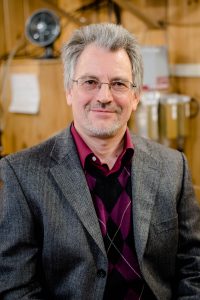
Dear Alumni and Friends!
I hope that this newsletter finds all of you and your families healthy and safe. Winter is in full swing in Houghton County, with over 30″ of snow this season so far. The Tech Trails are groomed, the broomball fields are set, our students have completed final exams and many are celebrating their recent graduation. As the holidays approach, I am happy to share some exciting developments that happened at the Department of Geological and Mining Engineering and Sciences since we sent you our previous newsletter in early June.
Before all, I am thrilled to report that our recently-reinstated Bachelor of Science in Mining Engineering program has been accredited by the Accreditation Board for Engineering and Technology (ABET). The meticulous accreditation process ensures that the program meets the strictest professional standards and provides the students with a solid educational foundation and posits them for successful and impactful careers. You can read more about it here.
Our faculty, staff, and students continued their diligent and productive work to move our department forward.
Due to the previous year’s cancellations, this summer we offered two sections of our Field Geology and Field Geophysics courses each. Everyone was happy to get back in the field for experiential learning. And to add to the excitement, our Field Geophysics students were the first cohort to take the advantage of cancellation of the laboratory fee, thanks to the Carl G. Schwenk Field Geophysics Lab Endowment.
Our faculty, alumni, and students have been recognized for their contributions and hard work. Most importantly, we celebrated two of our colleagues being named inaugural faculty fellows. Dr. Snehamoy Chatterjee, Associate Professor, was appointed the Witte Family Endowed Faculty Fellow in Mining Engineering; and Jeremy Shannon, Principal Lecturer, was named the Carl G. Schwenk Faculty Fellow in Applied Geophysics. We are extremely grateful to Carl Schwenk and the Witte family for their generosity, which will have a tremendous and long-lasting impact on the academic and professional successes of our students and faculty.
This fall, we congratulate Angela Hammond (BS ’00, MS ’02; Geological Engineering) who has been inducted into the Presidential Council of Alumnae.
Our students continue to be successful in their classes, participating in research, and presenting their work worldwide. These efforts have brought them much recognition. Most notably, our student chapter of the American Institute of Professional Geologists (AIPG) has been named the 2021 Student Chapter of the Year for the second year in a row! We also are very proud of Emily Street, a mining engineering senior, who won a prestigious nationwide 2021 Copper Club Lord Bagri Scholarship.
Last but not the least, our heartfelt congratulations go to our Summer and Fall 2021 graduates.
On behalf of our students, faculty, and staff, I would like to express my deepest appreciation to all of you who have provided support to our department! Your support is more important for us than ever during these challenging times. As we head toward 2022, we are aware of the hurdles we face, and the opportunities ahead. We look forward to your continued engagement with GMES as we recommit to our mission and goals.
As always, I will be happy to hear from you at any time by email (asmirnov@mtu.edu), phone (906.487.2365), or in-person (Dow 631).
Wishing you a very happy holiday season and a peaceful and prosperous new year!
Aleksey Smirnov
Professor and Chair
We are pleased to announce our Summer and Fall graduates. We are proud of you, and wish you the best of luck in your next chapter.
Leonid Surovitskii will soon graduate with a PhD in Geophysics. A highlight of his time here has been conducting fieldwork in China, Canada, and the U.S. Leo shared that all of his experience at Michigan Tech is a bright spot on his life path. Moving forward, Leo plans to publish more research papers and is looking forward to finding a postdoctoral position.
Domenicca (Dome) Guillen is graduating with an MS in Geology. Dome shared this when asked to reflect on the last two years: “My time at Michigan Tech was a self-revolution for me; I had to adapt myself to a new language, culture, and weather. Certainly, I have improved academically and even emotionally, during this time, and I thank MTU for who I am now. In terms of courses, I love the remote sensing courses and the course on geostatistics and data analysis.”
Katie Nelson will soon graduate with an MS in Geophysics. Katie is continuing with her research working towards a PhD. A few highlights of Katie’s time here have been playing on a broomball team her first year, getting to travel to do fieldwork, and meeting so many wonderful people.
Diana Bullen is graduating with an MS in Geology. After graduation, Diana plans on relocating back home to lower Michigan while searching for a job. When asked what she enjoyed and will miss the most, she had this to say, “I am going to miss all of my university Zoom friends the most. I am thankful that I got to meet such a great group of people. When I met them in person they were just as amazing as they were online!”
Nick Potter is graduating with an MS in Geology.
Ryan Klida is graduating with an MS in Geological Engineering.
Shubham Mahajan is graduating with an MS in Geological Engineering.
Sienna Meekhoff will soon graduate with a BS in Geology. Sienna had this to say about her time at Michigan Tech: “The highlight of my time here would have to be my involvement with the Geology Club and our AIPG student chapter. They really got me to open up to other students in and outside our department. I had several traveling opportunities with them, too, like our spring break trips to Arkansas, Virginia, North Carolina, and Tennessee as well as the AIPG national conferences in Burlington, Vermont, and Sacramento, California. I am going to miss the Keweenaw Peninsula the most. I love swimming in Lake Superior and finding agates on the beaches as well as skiing with the amazing scenery Ripley and Bohemia have to offer.”
Emilie Pray will soon graduate with a BS in Geology. After graduation, Emilie plans to stay at Michigan Tech to pursue an MS in Geology. The highlight of her time here so far has been the undergraduate research she’s conducted. Through it, she was able to learn a lot about the geology of the Upper Peninsula outside of the classroom. She studied some of the oldest rocks in the region! Working in the lab and collecting data were the hands-on experiences she wanted during her studies at Tech.
Hannah Hunt will soon graduate with a BS in Geology. Hannah is pictured using a Geonics EM-16 VLF receiver at Taylor Mine.
Cristhian Salas ’21 finished this summer, earning an MS in Geology. More details to come.
Sanna Mairet ’21 finished this summer and earned an MS in Geology. Info coming soon.
Kay Sivaraj ’21 finished this summer, graduating with an MS in Geology. Stay tuned for more details.
Stepan Pikul ’21 finished this summer, earning an MS in Geology. Check back later for full details.
Thanks to the generosity of alumnus Carl Schwenk our unique summer course in Field Geophysics has now become more affordable for our students. Starting this past summer, the Carl G. Schwenk Field Geophysics Lab Endowment began to cover all course expenses not tuition related, such as annual costs for travel, field supplies, periodic equipment maintenance, instrument rental, and equipment replacement. This support made it possible to reimburse the hefty $450 laboratory fee in full to each student who took the course this year. And no laboratory fee will be required for Field Geophysics in the future, starting in summer 2022.
“We all here in the GMES department are very grateful to Carl, who has made significant professional contributions to field geophysics and mineral exploration throughout his career,” says Aleksey Smirnov, chair of the Department of Geological and Mining Engineering and Sciences, “As an alum, he remains closely and actively involved with our department, providing tremendous support to our students over the years.”
Schwenk earned a BS in both Geological and Geophysical Engineering from Michigan Tech in 1962 and 1965, respectively. He worked as a Field Geophysicist with Kennecott Copper Corporation and was instrumental in the discovery of the Flambeau copper-gold Mine in Wisconsin. Later, he worked with the large iron company Vale do Rio Doce exploring for base metals in Brazil. After his return to the USA, he was hired as Great Lakes District Manager for Noranda Exploration and led a successful State Supreme Court challenge to Wisconsin’s Geologic Disclosure Law.
Principal Lecturer Jeremy Shannon, Carl G. Schwenk Endowed Faculty Fellow in Applied Geophysics, teaches the Field Geophysics courses at Michigan Tech. “This is a great gift for our students and I can’t wait to share Carl’s story of his contribution each summer,” he says. “The cost of equipment and resources used in the class is significant, but inevitably spread out over time scales that are beyond any student’s undergraduate career. Thus students are often left wondering what their lab fees are really being used for. Carl’s gift takes a dent out of the ever-increasing cost of a college education while ensuring that students will continue to have access to modern geophysical instrumentation.”
Olivia Salvagio, an applied geophysics senior, adds: “Field Geophysics was where I learned that I wanted to continue my education on near surface geophysics in graduate school! I was so intrigued by each of the methods and the equipment that we used and the broad applications that they have to Earth science.”
Emilie Pray, a geology senior, had this to say: “Field Geophysics was the class that fully cemented the concepts learned in the classroom into real-world applications. Along with practice in technical writing skills and group work in the field, I believe this class has prepared me well for my future career.”
Emilie Pray, a geology senior in the Department of Geological and Mining Engineering and Sciences (GMES), won first place in the American Institute of Professional Geologists (AIPG) Michigan Section Annual Student Poster Contest.
Pray’s poster was titled “The Exhumation History of the Bell Creek Batholith.” Her research has been advised by Chad Deering (GMES).
